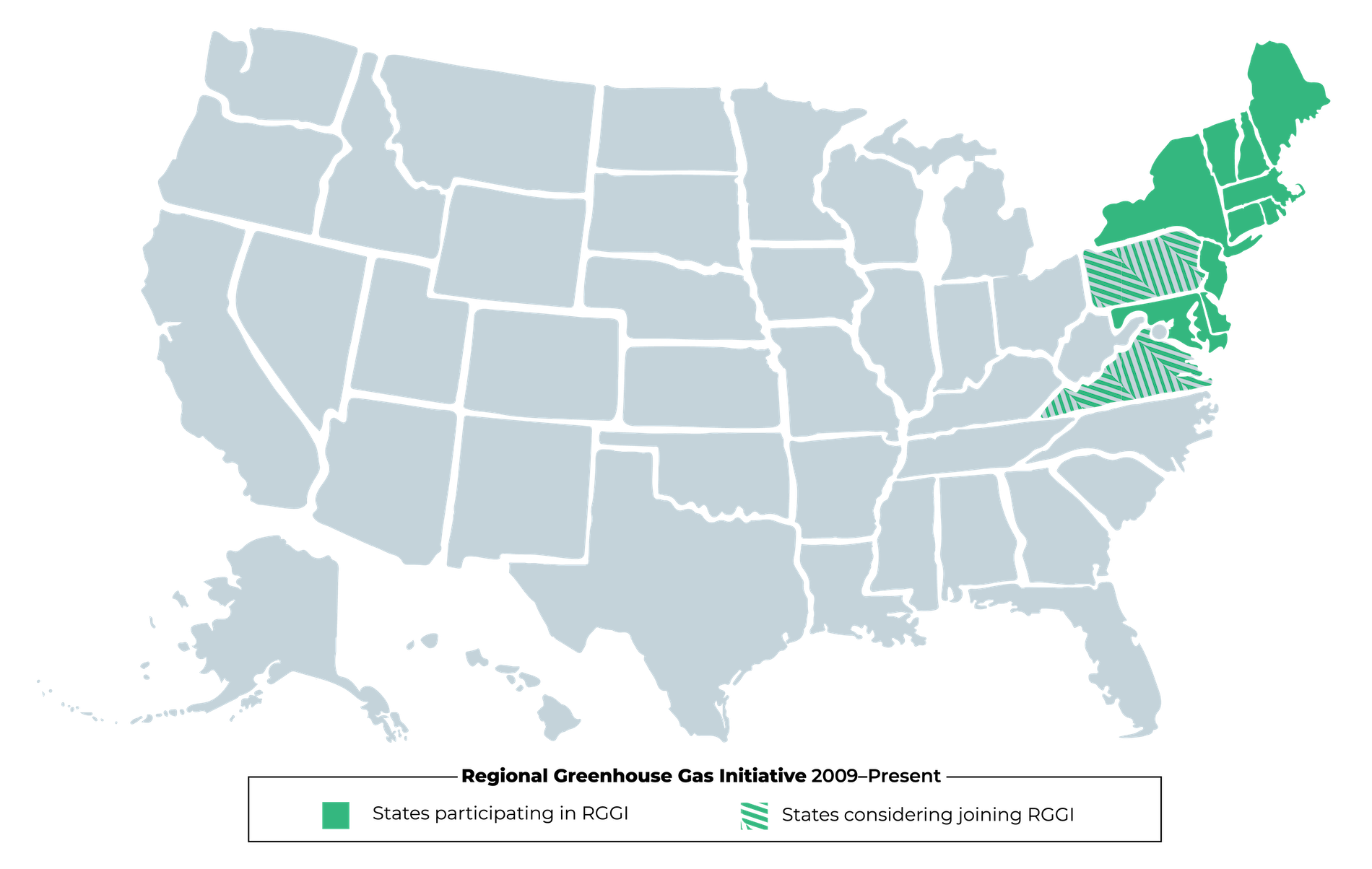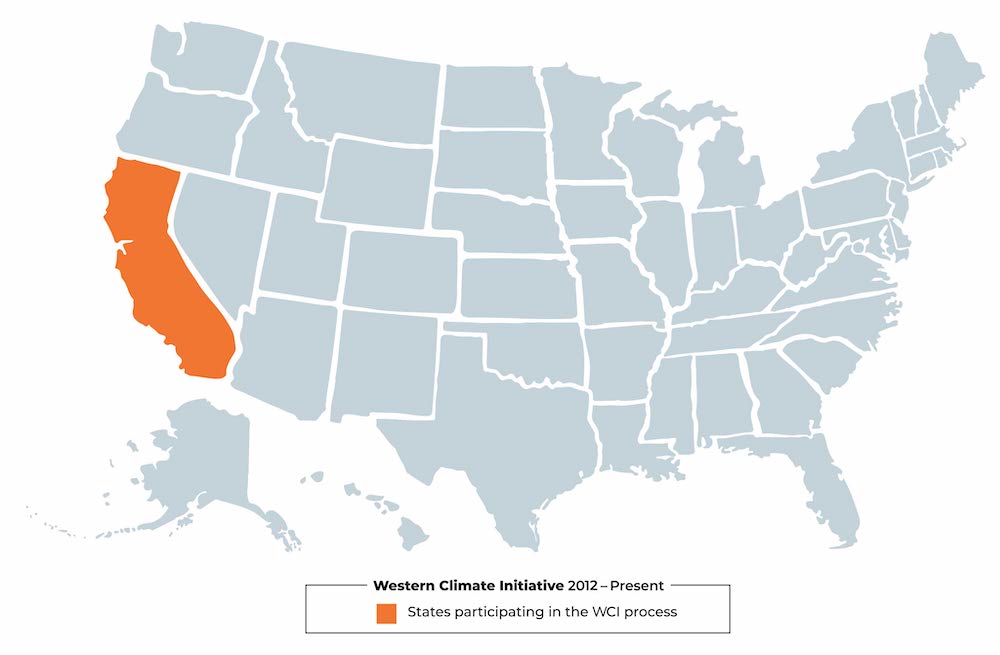REGIONAL CARBON PRICING INITIATIVES
Two cap-and-trade programs are currently operating in the United States: The REGIONAL GREENHOUSE GAS INITIATIVE (or RGGI for short)in the Northeast and Mid-Atlantic, and the WESTERN CLIMATE INITIATIVE, which involves California and Québec. The TRANSPORTATION AND CLIMATE INITIATIVE, an additional cap-and-trade program for transportation fuels, is also under development in the RGGI region.
For more on how cap-and-trade programs work, visit our Why Price Carbon? page
Regional Greenhouse Gas Initiative
Program Lifetime
2009–Present
Participating States
Connecticut, Delaware, Maine, Maryland, Massachusetts, New Hampshire, New York, Rhode Island, Vermont, New Jersey. Scheduled to join: Virginia. Under consideration: Pennsylvania.
Sectors Covered
In-state electricity generation
Current Price
$5.65/short ton CO₂ (March 2020)
Cap Trajectory
- 2005 Initial Program Design: 188 to 169 million short tons CO₂e, 2009-2018 (10% reduction)
- 2012 Program Review: 91 to 77 million short tons CO₂e, 2014-2020 (15% reduction)
- 2017 Program Review: 75 to 53 million short tons CO₂e, 2021-2030 (30% reduction)
Background
The Regional Greenhouse Gas Initiative is the longest-operating cap-and-trade program for greenhouse gases in the United States, reaching full implementation in 2009. Since implementation, the emissions cap has been adjusted downward multiple times, with 2020 cap levels constituting one-third of the cap level in 2009. As of 2018, emissions from RGGI power plants were 47% lower than 2008 levels, although a majority of these reductions have been attributed to factors other than RGGI.
To date, RGGI auctions have sold nearly all allowances at government auction for between $1.86 and $7.50 per short ton of CO₂, for a total of $3.5 billion in revenue that states have largely invested in energy efficiency and renewable energy programs. Studies find that each control period of RGGI (2009–2011, 2012–2014, 2015–2017) has added between $1.3 and $1.6 billion in economic benefits to the region from reduced energy costs. In addition, the program has generated almost $6 billion in net co-benefits from reducing co-pollutants, leading to improved public health and productivity.
In 2017, RGGI states agreed to extend the program through 2030, with a cap that decreases 30% between 2021 and 2030. Price containment mechanisms are designed to keep allowance prices between $6 and $13 per short ton of CO₂ beginning in 2021, increasing 7% each year after. Periodic reviews are scheduled to assess oversupply of allowances in the program, which could lead to further cap adjustments in the coming decade.
History
The Regional Greenhouse Gas Initiative (RGGI) was the first mandatory cap-and-trade program in the U.S., intended to reduce emissions in the electricity sector. In the absence of federal regulations, former New York Governor George Pataki issued a call to other governors in the region to design a mandatory program to limit emissions from the electric sector in 2003. On December 20th, 2005, the governors of Connecticut, Delaware, Maine, New Hampshire, New Jersey, New York, and Vermont announced an agreement to implement RGGI, outlined in a Memorandum of Understanding (MOU). In 2007, Maryland, Massachusetts, and Rhode Island joined the initiative by signing the MOU.
The program was designed so that individual states needed to enact legislation or regulations based on the RGGI model rule, released in 2006, to establish individual CO2 Budget Trading Programs. These programs limit carbon dioxide emissions, issue allowances, and establish participation in regional auctions for allowances. The first multi-state auctions occurred in September and December of 2008, and the first compliance period began on January 1, 2009. The original cap was set to approximately 188 million short tons of carbon dioxide for the entire region and was designed to decline by 2.5% annually between 2015 and 2018 — aiming to achieve a 10% reduction in emissions from power plants by 2019. The states had originally planned to give away the allowances to generators, who could then trade them, following the European Union’s Emissions Trading System (EU ETS). But advocacy by a coalition of environmental groups convinced the states that selling the allowances and using the funds for clean energy and other state programs made more sense.
Following a shift in administration, New Jersey formally withdrew from RGGI in 2012, but rejoined the program in 2020. In October of 2019, Governor Wolf announced plans for Pennsylvania to join RGGI. Virginia is expected to participate in RGGI starting in 2021, after the legislature passed a bill requiring the state to join the regional cap-and-invest program in early 2020.
Read More About State-Level Action in the RGGI Region on our SCPN Page
Read our Latest Coverage on RGGI
Will Pennsylvania Ever Join the Regional Greenhouse Gas Initiative?
As the second-largest producer of natural gas in the country and a state with large oil and gas industries, Pennsylvania has a long history of being dominated by fossil fuel interests. Many representatives in the legislative branch have close ties...
Virginia Joins the Regional Greenhouse Gas Initiative, Finally
In a tweet this July, Governor Ralph Northam announced Virginia's determination to tackle climate change by officially joining the Regional Greenhouse Gas Initiative (RGGI), a cap-and-invest program in the Northeast and Mid-Atlantic that places a limit on electricity sector emissions. “As...
Virginia set to join RGGI — A massive step forward for cap-and-invest
In a landmark decision last week, Virginia passed the Clean Economy Act in both the House and Senate. The legislation sets the state to join the Regional Greenhouse Gas Initiative (RGGI), a regional cap-and-invest program for the electric sector in...
Cap-and-Trade ambition renewed in 2019 after a decade of decline
With COP25 currently underway, market-based approaches to emissions reductions have been a major topic of negotiations among almost 200 countries, as they work to finalize rules under Article 6 of the Paris Agreement. On November 4th, the United States formally...
Transportation and Climate Initiative
Program status
Under consideration — Implementation expected in 2022
Considered jurisdictions
Connecticut, Delaware, Maryland, Massachusetts, New Jersey, Pennsylvania, Rhode Island, Vermont, Virginia, Washington DC. Observers: Maine, New York
Sectors Covered
On-road transportation (gasoline and diesel)
Background
The Transportation and Climate Initiative (TCI) is a regional cap-and-invest program under consideration for transportation emissions in the Northeast and Mid-Atlantic. The program would require fuel distributors to purchase permits according to the consumption of their product in participating states, raising revenue for clean transportation investment.
Most TCI states signed a letter of intent in December 2018 to undertake a thorough and expedient process to design and negotiate the program. A year later, in December 2019, the states released preliminary modeling results and a draft MOU, suggesting that the states are considering a cap reduction of 20% to 25% between 2022 and 2032. A final MOU is expected in the fall of 2020, following additional public input and analysis. At that time, each TCI jurisdiction will decide whether to sign the final MOU and participate in the regional program, anticipated to launch in 2022.
New Hampshire has formally withdrawn from the TCI process, while New York and Maine remain in observer status of the TCI program. Many of the TCI states already participate in the Regional Greenhouse Gas Initiative. The two programs combined have the potential to cover a majority of the region’s emissions, although the ambition of the TCI program is yet to be determined.
Read More About State-Level Action in the TCI Region on our SCPN Page
Read our Latest Coverage on TCI
Next for TCI: Draft Model Rule, State Level Implementation, and New Findings on Program Benefits
The public comment period on the Transportation and Climate Initiative Program's (TCI-P) Draft Model Rule and processes for public engagement wraps up on May 7th. Meanwhile, legislators in Massachusetts, Connecticut, and Rhode Island are working to pass the legislation needed to...
TCI Public Comment Period Wraps Up Next Week
As the public comment period wraps up for the Transportation and Climate Initiative (TCI) next week, states are preparing for the last push to finalize a Memorandum of Understanding (MOU) by the spring. The public got their first glimpse of the...
TCI releases draft policy design: What you need to know
The Transportation and Climate Initiative (TCI) states have released both a draft MOU and multiple policy scenarios for a regional cap-and-invest program on transportation emissions. The release comes almost exactly a year after they first signed a statement of intent...
What the Transportation and Climate Initiative Means for State Climate Policy: Recap
This webinar is part of the State Carbon Pricing Network’s Deep Dive webinar series Each month, we explore a carbon pricing topic in depth, bringing in experts and pushing forward the conversation. Transportation is currently expensive, inefficient and highly polluting. Passenger cars...
Western Climate Initiative
Program status
In effect 2012–Present
Participating Jurisdictions
California, Québec
Sectors Covered
- 2012–2014: Electricity, Industrial Facilities
- 2015 onward: Electricity, Transportation, Buildings, Industrial Facilities
Price at Latest Auction
$16.88/metric ton CO₂ (May 2020)
Cap Trajectory
- 2013-2014: 163 to 160 million metric tons CO₂e (1.9% reduction)
- 2015-2020: 395 to 334 million metric tons CO₂e (15% reduction)
- 2021-2031: 321 to 194 million metric tons CO₂e (40% reduction)
Background
The Western Climate Initiative (WCI) is an economy-wide cap-and-invest program currently linked between California and Quebec.
The first compliance period, beginning in 2013, was designed to regulate emissions from in-state electricity generation, electricity imports, large industrial facilities, and other stationary emissions sources. The second compliance period, beginning in 2015, expanded to include suppliers of natural gas, diesel, gasoline, and other fossil fuels to in-state users.
Allowance prices have fluctuated between $10.09 and $17.87 per metric ton CO₂ since program launch, raising over $13.1 billion USD for California Climate Investments and $4.1 billion CAD for Quebec’s Green Fund. Both jurisdictions direct these funds largely towards programs that further reduce greenhouse gases and produce other co-benefits.
California achieved their 2020 emissions target 4 years early in 2016, largely due to substantial reductions in electricity sector emissions. As part of California’s Scoping Plans, cap-and-trade was designed as a backstop through 2020, allowing complementary policies such as fuel efficiency standards, energy efficiency, and renewable portfolio standards to drive the majority of emissions reductions.
In 2017, California renewed the program through 2030 with a legislative supermajority. A 2017 updated Scoping Plans anticipates the program to contribute 38% of the reductions needed to achieve a 2030 target of 40% below 2020 levels.
History
WCI was first created in 2007, when the governors of Arizona, California, New Mexico, Oregon, and Washington signed the Western Regional Climate Action Initiative. By 2008, Montana and Utah joined the initiative, as well as the Canadian provinces British Columbia, Manitoba, Ontario and Quebec. Additional observers included Alaska, Idaho, Wyoming, Nevada, Colorado, and Kansas; the Canadian province of Saskatchewan, and the Mexican states Baja California, Chihuahua, Coahulia, Nuevo Leon, Sonora, and Tamaulipas.
The initiative aimed to collectively reduce regional emissions to 15% below 2005 levels by 2020, with a regional economy-wide cap-and-trade program as the centerpiece. The WCI also requires that states adopt GHG emission reduction targets, and implement an action plan with complementary policies to achieve these goals. States were also required to adopt California’s vehicle greenhouse gas emissions standards, and be a part of the Climate Registry, an organization that helps to measure and report greenhouse gas emissions.
By November 2011, due to the recession, changes in state leadership, and unsupportive legislatures, New Mexico, Arizona, Washington, Oregon, Montana, and Utah all formally declined to participate in WCI, leaving Canada and four Canadian provinces as the remaining participants. California and Quebec followed through with a linked cap-and-trade program in 2013. In 2017, Ontario linked cap-and-trade programs with California and Quebec, but ended the program in July 2018 following a change in executive leadership.
Read our Latest Coverage on WCI
Delivering on Justice40: Perspectives from State Agency Staff
Delivering on Justice40: Perspectives from State Agency Staff This report surveys the barriers that state agency staff face when deploying federal climate and clean energy funds to priority communities. Based on interviews with 16 state agency managers of Justice40 covered programs,...
To Achieve Environmental Justice, States Need to First Define It
The latest Intergovernmental Panel on Climate Change (IPCC) report stresses that our window of opportunity to secure a livable future is rapidly closing, with those most vulnerable to the changing climate being recognized as primarily belonging to low-income communities or...
“The most important thing an individual can do, is be a little less of an individual”
A Conversation with Bill McKibben If you care about the climate crisis, or generally have been paying attention to the climate movement over the span of the past few decades, it is likely that you are more than familiar with Bill...
“Lo más importante que puede hacer un individuo es ser menos individualista”
Una conversación con Bill McKibben A medida que descubrimos más y más paralelos entre el COVID-19 y la crisis climática, tenemos una necesidad crítica de entender los sistemas que han perpetuado inequidades sociales y económicas que han exacerbado el sufrimiento causado...














